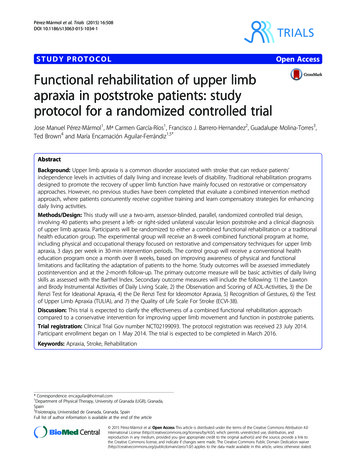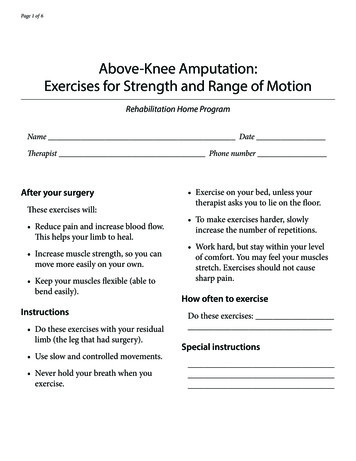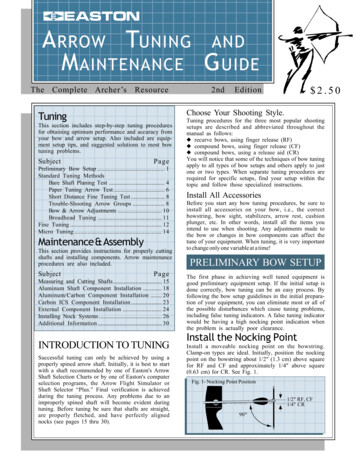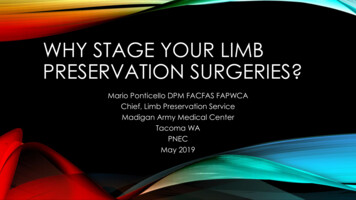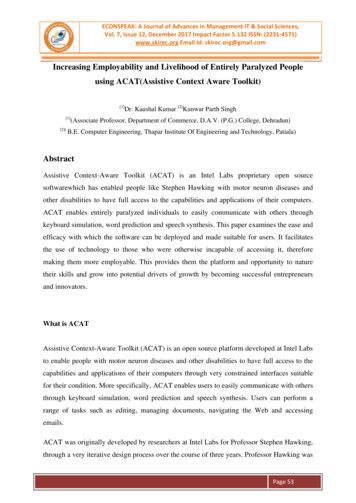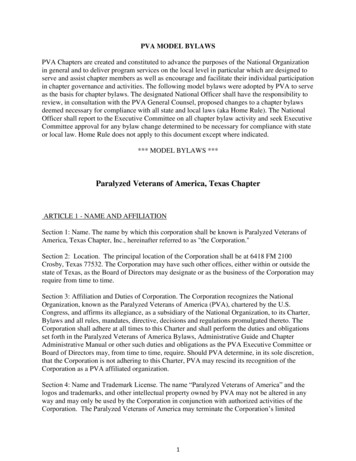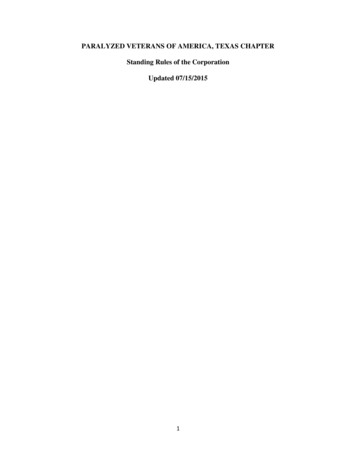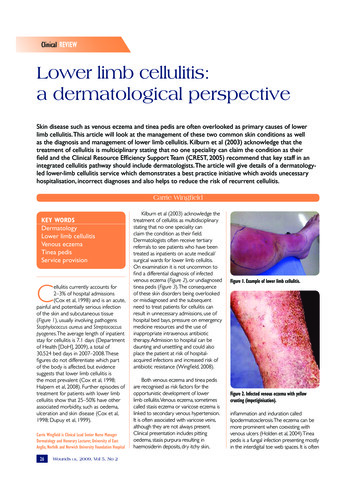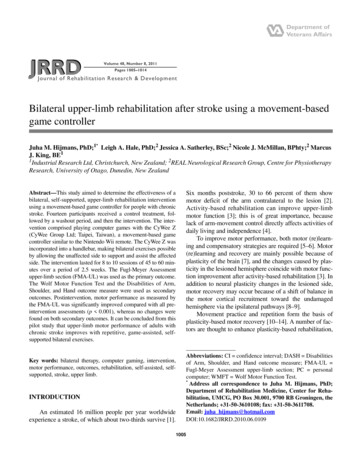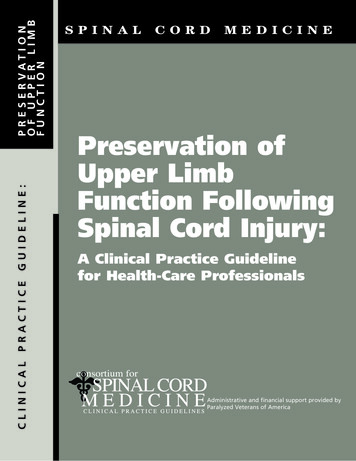
Transcription
P R E S E RVAT I O NOF UPPER LIMBFUNCTIONCLINICAL PRACTICE GUIDELINE:SPINALCORDMEDICINEPreservation ofUpper LimbFunction FollowingSpinal Cord Injury:A Clinical Practice Guidelinefor Health-Care ProfessionalsAdministrative and financial support provided byParalyzed Veterans of America
Consortium for Spinal Cord MedicineMember OrganizationsAmerican Academy of Orthopedic SurgeonsAmerican Academy of Physical Medicine and RehabilitationAmerican Association of Neurological SurgeonsAmerican Association of Spinal Cord Injury NursesAmerican Association of Spinal Cord Injury Psychologists and Social WorkersAmerican College of Emergency PhysiciansAmerican Congress of Rehabilitation MedicineAmerican Occupational Therapy AssociationAmerican Paraplegia SocietyAmerican Physical Therapy AssociationAmerican Psychological AssociationAmerican Spinal Injury AssociationAssociation of Academic PhysiatristsAssociation of Rehabilitation NursesChristopher Reeve Paralysis FoundationCongress of Neurological SurgeonsInsurance Rehabilitation Study GroupInternational Spinal Cord SocietyParalyzed Veterans of AmericaU.S. Department of Veterans AffairsUnited Spinal Association
CLINICALPRACTICEGUIDELINESpinal Cord MedicinePreservation of Upper LimbFunction Following Spinal CordInjury:A Clinical Practice Guidelinefor Health-Care ProfessionalsConsortium for Spinal Cord MedicineAdministrative and financial support provided by Paralyzed Veterans of America Copyright 2005, Paralyzed Veterans of AmericaNo copyright ownership claim is made to any portion of these materials contributed by departments or employeesof the United States Government.This guideline has been prepared based on the scientific and professional information available in2004. Users of this guideline should periodically review this material to ensure that the adviceherein is consistent with current reasonable clinical practice.April 2005ISBN: 0-929819-17-9
iiiTable of nel MembersixContributors1Summary of Recommendations3The Consortium for Spinal Cord Medicine34777799101113212225GUIDELINE DEVELOPMENT PROCESSMETHODOLOGYIntroductionWRIST AND CTSELBOWSHOULDERIMPACT OF PAINERGONOMICS AND UPPER LIMB INJURYRecommendationsERGONOMICSEQUIPMENT SELECTION, TRAINING, AND ENVIRONMENTAL ADAPTATIONSEXERCISEMANAGEMENT OF ACUTE AND SUBACUTE UPPER LIMB INJURIES AND PAINTREATMENT OF CHRONIC MUSCULOSKELETAL PAIN TO MAINTAIN FUNCTION29Recommendations for Future Research30References36Index
vForewordFor individuals with spinal cord injury (SCI), paralysis of the lower limbs necessitates reliance on the upper limbs for mobility. This greater reliance on thearms can lead to pain and injury, which can have an impact not only on mobility, but also on the ability to complete activities of daily living. The high prevalence of upper limb pain and injury in SCI is well documented, as are thenegative consequences on quality of life. Unfortunately, little research exists thatclearly documents how to prevent upper limb pain and injury and thus preservefunction. The purpose of this guideline is to provide health-care professionalswith concise, practical information that will help them prevent and treat upperlimb pain and injury in their patients.This guideline is unique in that we relied heavily on a field of specialists outside of SCI and traditional medicine for support of many of therecommendations. Ergonomics is a branch of engineering that studies therelationship between workers and their environment. The ergonomics literature was reviewed and is interspersed throughout the recommendations. A separate literature grade is provided to enable the reader toascertain to what level the recommendation is supported by the ergonomics literature. And, with the guidance of our methodologist, we combinedthe ergonomic, epidemiologic, and health sciences research into a singlegrade of recommendation.The multidisciplinary panel responsible for this guideline extensivelydebated what to include and what not to include. To keep the documentmanageable in terms of both size and scope, we omitted topics that easilycould have been included. For example, we did not include information onmanagement of the upper limbs at the time of the acute SCI because afuture guideline is likely to cover that topic. Another area we did notcover is procedures to improve upper limb function, such as tendon transfers or functional electrical stimulation. We are hopeful that this area, too,will be covered in a future practice guideline. Finally, we only brieflytouched on the management of chronic musculoskeletal pain.The panelists are aware that this guideline is but a beginning step inthe ongoing process of developing useful tools for preserving upper limbfunction in individuals with SCI. It is the panel’s hope that the guidelinewill stimulate research in this vital area and provide guidance in dealingwith the complexities of upper limb pain and injury in SCI. Preservationof Upper Limb Function Following Spinal Cord Injury: A ClinicalPractice Guideline for Health-Care Professionals is the result of a collaborative effort among a group of professionals with extensive researchand clinical experience. Their hard work and vision are reflected in thepages of this document.Michael L. Boninger, MDPanel Chair
viPrefaceAs chair of the Steering Committee of the Consortium for Spinal CordMedicine, it gives me great pleasure to deliver to the health-care communityour latest publication, Preservation of Upper Limb Function FollowingSpinal Cord Injury. Michael L. Boninger, MD, and his excellent panel havedeveloped a document that draws on the best scientific evidence and thebest available clinical experience to address the needs of persons with spinalcord injury and the secondary conditions that we see so often in ourpatients. The possibility of preventing problems with the upper limb is aparticularly strong component of this document.With this publication we are initiating a new process for grading andincluding relevant evidence. Marcel P.J.M. Dijkers, PhD, and his colleaguesat Mt. Sinai School of Medicine have expanded our approach to the scientific literature to give a more robust foundation to the work of the panel.Throughout the history of the consortium, we have struggled with theweaknesses of the published literature on some of our topics when theSackett criteria were strictly applied and relevant articles were excludedfrom use. Dr. Dijkers has given us some new tools with which to draw uponrelevant research and publications while still disclosing the strengths andweaknesses of the scientific basis for the panel’s recommendations.I want to offer my personal thanks to Robert L. Waters, MD, who hasserved again as topic champion for this panel. Dr. Waters has been anintegral part of the development of the consortium from its inception anda consistent supporter of the topic development work of several panels.Dr. Waters, you have our gratitude.Once again, the Paralyzed Veterans of America has given us excellentresources and support to bring this document to the health-care field.From the Office of the National President down to the Research,Education, and Practice Guidelines program, we continue to receiveencouragement to do what we do. Kim S. Nalle, the newest member of thePVA team, has been a welcome addition. Her interpersonal skills and organizational talents have added to the strength of our process.My gratitude for J. Paul Thomas is still growing! We appreciate himkeeping us on mission to improve the quality of health care for personswith spinal cord injury.Kenneth C. Parsons, MDChair, Steering CommitteeConsortium for Spinal Cord Medicine
viiAcknowledgmentsThe chairman and members of the upper limb preservation guidelinedevelopment panel wish to express special appreciation to the individuals andprofessional organizations who are members of the Consortium for Spinal CordMedicine and to the expert clinicians and health-care providers who reviewed thedraft document. A special thanks goes to the consumers, advocacy organizations,and staff of the numerous medical facilities and spinal cord injury rehabilitationcenters who contributed their time and expertise to the development of thisguideline.Marcel P.J.M. Dijkers, PhD, and colleagues at the Mt. Sinai School of Medicine,Department of Rehabilitation Medicine, New York City, served as consultantmethodologists. They masterfully conducted the initial and secondary-level literaturesearches, evaluated the quality and strength of the scientific evidence, constructedevidence tables, and graded the quality of research for all identified literaturecitations. This included an evaluation of currently used grading schema anddevelopment of a new, innovative method for grading specialized spinal cord injuryand related rehabilitation research.Members of the consortium steering committee, representing 21 professional,payer, and consumer organizations, were joined in the guideline developmentprocess by more than 40 expert reviewers. Through their critical analysis andthoughtful comments, the recommendations were refined and additional supportingevidence from the scientific literature was identified. The quality of the technicalassistance by these dedicated reviewers contributed significantly to the professionalconsensus building that is hopefully achieved through the guideline developmentprocess. Attorney William H. Archambault conducted a comprehensive analysis ofthe legal and health policy issues associated with this complex, multifaceted topic.In addition, the consortium and development panel are most appreciative for theexcellent consultation and technical review provided by Michal Atkins, OTR/L, MA,and the illustrations and figures provided by the Rancho Los Amigos NationalRehabilitation Center, Downey, California. Also acknowledged for their technicalcontributions to the graphics are Marilyn Pires, RN, MS; Claire E. Beekman, PT, MS;Lydia Cabico, medical illustrator; and Bertha Cabral, OTR/L.Special recognition is warranted for two expert consultants: Thomas Armstrong,PhD, and Richard Hughes, PhD, both from the University of Michigan, who reviewedand graded the ergonomics-based recommendations using accepted principles of thebiomechanical, physiological, psychophysical, and epidemiological ergonomicsliterature as well as standard ergonomic practices. Also, the contributions of FabrisiaAmbrosio, MPT, MS, research associate in the Department of Rehabilitation Science,University of Pittsburgh, were invaluable to the exercise sections of the document.The guideline development panel is grateful for the many technical supportservices provided by various departments of the Paralyzed Veterans of America. Inparticular, the panel recognizes J. Paul Thomas and Kim S. Nalle in the consortiumcoordinating office for their help in organizing and managing the process; James A.Angelo and Kelly Saxton in the Communications program for their guidance inwriting, formatting, and creating art; and medical editor Joellen Talbot for herexcellent technical review and editing of the clinical practice guideline. Appreciationis expressed for the steadfast commitment and enthusiastic advocacy of the entirePVA board of directors and of PVA’s senior officers, including National PresidentRandy L. Pleva, Sr.; Immediate Past President Joseph L. Fox, Sr.; Executive DirectorDelatorro L. McNeal; Deputy Executive Director John C. Bollinger; and Director ofResearch, Education, and Practice Guidelines Thomas E. Stripling. Their generousfinancial support has made the CPG consortium and its guideline developmentprocess a success.
viiiPanel MembersMichael L. Boninger, MDPanel Chair(Physical Medicine and Rehabilitation)University of PittsburghVA Pittsburgh Healthcare SystemPittsburgh, PARobert L. Waters, MDLiaison to the Consortium Steering Committee and Topic Champion(Orthopedic Surgery)Rancho Los Amigos Medical CenterDowney, CATheresa Chase, MA, ND, RN(SCI Nursing)Craig HospitalEnglewood, COMarcel P.J.M. Dijkers, PhD(Evidence-Based Practice Methodology)Mt. Sinai School of MedicineNew York, NYHarris Gellman, MD(Orthopedic Surgery)Bascom Palmer InstituteMiami, FLRonald J. Gironda, PhD(Clinical Psychology)James A. Haley VA Medical CenterTampa, FLBarry Goldstein, MD(Physical Medicine and Rehabilitation)VA Puget Sound Health Care SystemSeattle, WASusan Johnson-Taylor, OTR(Occupational Therapy)Rehabilitation Institute of ChicagoChicago, ILAlicia Koontz, PhD, RET(Rehabilitation Engineering)VA Pittsburgh Healthcare SystemPittsburgh, PAShari L. McDowell, PT(Physical Therapy)Shepherd CenterAtlanta, GA
ixContributorsConsortium Member Organizationsand Steering CommitteeRepresentativesAmerican Academy of Orthopedic SurgeonsU.S. Department of Veterans AffairsMargaret C. Hammond, MDUnited Spinal AssociationVivian Beyda, DrPHE. Byron Marsolais, MDAmerican Academy of Physical Medicine and RehabilitationMichael L. Boninger, MDAmerican Association of Neurological SurgeonsPaul C. McCormick, MDAmerican Association of Spinal Cord Injury NursesLinda Love, RN, MSAmerican Association of Spinal Cord Injury Psychologistsand Social WorkersRomel W. Mackelprang, DSWAmerican College of Emergency PhysiciansWilliam C. Dalsey, MD, FACEPExpert ReviewersAmerican Academy of Orthopedic SurgeonsMichael W. Keith, MDMetroHealth Medical CenterAmerican Academy of Physical Medicine and RehabilitationDavid R. Gater, Jr., MD, PhDUniversity of Michigan/VA Ann Arbor Healthcare SystemJames K. Richardson, MDUniversity of Michigan, Department of Physical Medicineand RehabilitationAmerican Association of Spinal Cord Injury NursesKathleen L. Dunn, MS, RN, CRRN-A, CNSVA San Diego Healthcare SystemAmerican Congress of Rehabilitation MedicineMarilyn Pires, MS, RN, CRRN-A, FAANSusan I. Pejoro, RN, MS, GNPVA Palo Alto Health Care SystemAmerican Occupational Therapy AssociationTheresa Gregorio-Torres, MA, OTRAmerican Paraplegia SocietyLawrence C. Vogel, MDAmerican Physical Therapy AssociationMontez Howard, PT, MEdAmerican Psychological AssociationDonald G. Kewman, PhD, ABPPAmerican Spinal Injury AssociationMichael M. Priebe, MDAssociation of Academic PhysiatristsWilliam O. McKinley, MDAssociation of Rehabilitation NursesAmerican Association of Spinal Cord Injury Psychologists andSocial WorkersMichael Dunn, PhDSCI Service, VA Palo Alto Health Care SystemDavid W. Hess, PhD, ABPPVirginia Commonwealth UniversityTerrie L. Price, PhDRehabilitation Institute of Kansas CityMarcia J. Scherer, PhD, FACRMInstitute for Matching Person and Technology, Inc.American Congress of Rehabilitation MedicineMichal S. Atkins, OTR/L, MARancho Los Amigos National Rehabilitation CenterCraig J. Newsam, DPTRancho Los Amigos National Rehabilitation CenterAudrey Nelson, PhD, RNChristopher Reeve Paralysis FoundationMarilyn Pires, RN, MS, CRRN-A, FAANRancho Los Amigos National Rehabilitation CenterSamuel MaddoxAmerican Occupational Therapy AssociationCongress of Neurological SurgeonsPaul C. McCormick, MDInsurance Rehabilitation Study GroupLouis A. Papastrat, MBA, CDMS, CCMInternational Spinal Cord SocietyJohn F. Ditunno, Jr., MDParalyzed Veterans of AmericaJames W. Dudley, BSMECarole Adler, BA, OTR/LSanta Clara Valley Medical CenterMary Shea, MA, OTR, ATPMt. Sinai Medical CenterValerie Willette, OTR, CHTAmerican Society of Hand Therapists (ASHT)Texas State Chapter of ASHT
xAmerican Paraplegia SocietyInsurance Rehabilitation Study GroupChester H. Ho, MDLouis Stokes VA Medical CenterLouis A. Papastrat, MBA, CDMS, CCMAmerican Re HealthcareSteven Kirshblum, MDKessler Institute for RehabilitationAdam L. Seidner, MD, MPHSt. Paul Travelers Insurance CompaniesAmerican Physical Therapy AssociationJames Urso, BASt. Paul Travelers Insurance CompaniesClaire E. Beekman, PT, MS, NCSRancho Los Amigos National Rehabilitation CenterInternational Spinal Cord SocietyBarbara Garrett, PTKessler Institute for RehabilitationSharon Russo, MS, PTWoodrow Wilson Rehabilitation CenterFin Biering-Sorensen, MDClinic for Para- and Tetraplegia,Neuroscience CentreRigshospitalet Copenhagen University HospitalParalyzed Veterans of AmericaAmerican Psychological AssociationLester Butt, PhD, ABPPCraig HospitalDonald G. Kewman, PhD, ABPPAmerican Psychological AssociationAmerican Spinal Injury AssociationSam C. Colachis III, MDOhio State UniversityJennifer Hastings, PT, NCSUniversity of WashingtonMichael Priebe, MDEdward Hines, Jr., VA Medical CenterJames AngeloKelly SaxtonUnited Spinal AssociationRobert L. Waters, MDRancho Los Amigos National Rehabilitation CenterU.S. Department of Veterans AffairsDouglas B. Barber, MDUniversity of Texas Health Science CenterSunil Sabharwal, MDVA Boston Healthcare SystemYvonne Lucero, MDHines VAMC/SCISAssociation of Academic PhysiatristsSam C. Colachis III, MDOhio State UniversitySteven Kirshblum, MDKessler Institute for RehabilitationAssociation of Rehabilitation Nurses“Sis” Theuerkauf, MEd, RN, CRRN, CCMEducation and Support Consultants, Inc.Special ReviewersThomas Armstrong, PhDUniversity of MichiganRichard Hughes, PhDUniversity of Michigan
1Summary of RecommendationsInitial Assessment of Acute SCI1. Educate health-care providers and persons withSCI about the risk of upper limb pain and injury,the means of prevention, treatment options, andthe need to maintain fitness.2. Routinely assess the patient’s function, ergonomics, equipment, and level of pain as part of aperiodic health review. This review should includeevaluation of:Transfer and wheelchair propulsiontechniques.pushrim, the angle between the upper arm andforearm is between 100 and 120 degrees.10. Educate the patient to:Use long, smooth strokes that limit highimpacts on the pushrim.Allow the hand to drift down naturally,keeping it below the pushrim when not inactual contact with that part of thewheelchair.11. Promote an appropriate seated posture and stabilization relative to balance and stability needs.Equipment (wheelchair and transfer device).Current health status.Ergonomics3. Minimize the frequency of repetitive upper limbtasks.4. Minimize the force required to complete upperlimb tasks.5. Minimize extreme or potentially injurious positionsat all joints.12. For individuals with upper limb paralysis and/orpain, appropriately position the upper limb in bedand in a mobility device. The following principlesshould be followed:Avoid direct pressure on the shoulder.Provide support to the upper limb at allpoints.When the individual is supine, position theupper limb in abduction and externalrotation on a regular basis.Avoid extreme positions of the wrist.Avoid pulling on the arm when positioningindividuals.Avoid positioning the hand above theshoulder.Remember that preventing pain is a primarygoal of positioning.Avoid potentially injurious or extremepositions at the shoulder, including extremeinternal rotation and abduction.Equipment Selection, Training, andEnvironmental Adaptations6. With high-risk patients, evaluate and discuss thepros and cons of changing to a power wheelchairsystem as a way to prevent repetitive injuries.7. Provide manual wheelchair users with SCI a highstrength, fully customizable manual wheelchairmade of the lightest possible material.8. Adjust the rear axle as far forward as possiblewithout compromising the stability of the user.9. Position the rear axle so that when the hand isplaced at the top dead-center position on the13. Provide seat elevation or possibly a standing position to individuals with SCI who use power wheelchairs and have arm function.14. Complete a thorough assessment of the patient’senvironment, obtain the appropriate equipment,and complete modifications to the home, ideally toAmericans with Disabilities Act (ADA) standards.15. Instruct individuals with SCI who complete independent transfers to:Perform level transfers when possible.Avoid positions of impingement whenpossible.Avoid placing either hand on a flat surfacewhen a handgrip is possible during transfers.Vary the technique used and the arm thatleads.
2PRESERVATION OF UPPER LIMB FUNCTION FOLLOWING SPINAL CORD INJURY16. Consider the use of a transfer-assist device for allindividuals with SCI. Strongly encourage individuals with arm pain and/or upper limb weakness touse a transfer-assist device.Exercise17. Incorporate flexibility exercises into an overall fitness program sufficient to maintain normal glenohumeral motion and pectoral muscle mobility.18. Incorporate resistance training as an integral partof an adult fitness program. The training should beindividualized and progressive, should be of sufficient intensity to enhance strength and muscularendurance, and should provide stimulus to exercise all the major muscle groups to pain-freefatigue.Management of Acute and SubacuteUpper Limb Injuries and Pain19. In general, manage musculoskeletal upper limbinjuries in the SCI population in a similar fashionas in the unimpaired population.20. Plan and provide intervention for acute pain asearly as possible in order to prevent the development of chronic pain.21. Consider a medical and rehabilitative approach toinitial treatment in most instances of nontraumaticupper limb injury among individuals with SCI.26. Closely monitor the results of treatment, and if thepain is not relieved, continued work-ups and treatment are appropriate.27. Consider surgery if the patient has chronic neuromusculoskeletal pain and has failed to regain functional capacity with medical and rehabilitativetreatment and if the likelihood of a successful surgical and functional outcome outweighs the likelihood of an unsuccessful procedure.28. Operate on upper limb fractures if indicated andwhen medically feasible.29. Be aware of and plan for the recovery time neededafter surgical procedures.30. Assess the patient’s use of complementary andalternative medicine techniques and beware ofpossible negative interactions.Treatment of ChronicMusculoskeletal Painto Maintain Function31. Because chronic pain related to musculoskeletaldisorders is a complex, multidimensional clinicalproblem, consider the use of an interdisciplinaryapproach to assessment and treatment planning.Begin treatment with a careful assessment of thefollowing:Etiology.Pain intensity.22. Because relative rest of an injured or postsurgicalupper limb in SCI is difficult to achieve, stronglyconsider the following measures:Use of resting night splints in carpal tunnelsyndrome.Home modifications or additional assistance.Admission to a medical facility if pain cannotbe relieved or if complete rest is indicated.Functional capacities.Psychosocial distress associated with thecondition.32. Treat chronic pain and associated symptomatology in an interdisciplinary fashion and incorporate multiple modalities based on the constellationof symptoms revealed by the comprehensiveassessment.23. Place special emphasis on maintaining optimalrange of motion during rehabilitation from upperlimb injury.33. Monitor outcomes regularly to maximize the likelihood of providing effective treatment.24. Consider alternative techniques for activities whenupper limb pain or injury is present.34. Encourage manual wheelchair users with chronicupper limb pain to seriously consider use of apower wheelchair.25. Emphasize that the patient’s return to normalactivity after an injury or surgery must occurgradually.35. Monitor psychosocial adjustment to secondaryupper limb injuries and provide treatment ifnecessary.
CLINICAL PRACTICE GUIDELINEThe Consortium forSpinal Cord MedicineSeventeen organizations, including the ParalyzedVeterans of America (PVA), joined in a consortium in June 1995 to develop clinical practiceguidelines in spinal cord medicine. A steeringcommittee governs consortium operation, leadingthe guideline development process, identifyingtopics, and selecting panels of experts for eachtopic. The steering committee is composed ofone representative with clinical practice guidelineexperience from each consortium member organization. PVA provides financial resources,administrative support, and programmatic coordination of consortium activities.After studying the processes used to developother guidelines, the consortium steering committee unanimously agreed on a new, modifiedclinical/epidemiologic evidence-based modelderived from the Agency for Health Care Researchand Quality (AHRQ). The model is:Interdisciplinary, to reflect the variedperspectives of the spinal cord medicinepractice community.Responsive, with a timeline of 12 months forcompletion of each set of guidelines.Reality-based, to make the best use of thetime and energy of the busy clinicians whoserve as panel members and field expertreviewers.The consortium’s approach to the development of evidence-based guidelines is both innovative and cost-efficient. The process recognizes thespecialized needs of the national spinal cord medicine community, encourages the participation ofboth payer representatives and consumers withspinal cord injury, and emphasizes the use of graded evidence available in the international scientificliterature.The Consortium for Spinal Cord Medicine isunique to the clinical practice guidelines field inthat it employs highly effective management strategies based on the availability of resources in thehealth-care community; it is coordinated by a recognized national consumer organization with areputation for providing effective service andadvocacy for people with spinal cord injury anddisease; and it includes third-party and reinsurancepayer organizations at every level of the development and dissemination processes. The consortium expects to initiate work on two or moretopics per year, with evaluation and revision ofpreviously completed guidelines as new researchdemands.Guideline DevelopmentProcessThe guideline development process adoptedby the Consortium for Spinal Cord Medicine consists of 12 steps, leading to panel consensus andorganizational endorsement. After the steeringcommittee chooses a topic, a panel of experts isselected. Panel members must have demonstratedleadership in the topic area through independentscientific investigation and publication. Following adetailed explication and specification of the topicby select steering committee and panel members,consultant methodologists review the internationalliterature, prepare evidence tables that grade andrank the quality of research, and conduct statistical meta-analyses and other specialized studies, asneeded. The panel chair then assigns specific sections of the topic to the panel members based ontheir area of expertise. Writing begins on eachcomponent using the references and other materials furnished by the methodology support group.After panel members complete their sections, adraft document is generated during the first fullmeeting of the panel. The panel incorporates newliterature citations and other evidence-based information not previously available. At this point,charts, graphs, algorithms, and other visual aids, aswell as a complete bibliography, are added, and thefull document is sent to legal counsel for review.After legal analysis to consider antitrust,restraint-of-trade, and health policy matters, thedraft document is reviewed by clinical experts fromeach of the consortium organizations plus otherselect clinical experts and consumers. The reviewcomments are assembled, analyzed, and enteredinto a database, and the document is revised toreflect the reviewers’ comments. Following a second legal review, the draft document is distributedto all consortium organization governing boards.Final technical details are negotiated among thepanel chair, members of the organizations’ boards,and expert panelists. If substantive changes arerequired, the draft receives a final legal review. Thedocument is then ready for editing, formatting, andpreparation for publication.3
4PRESERVATION OF UPPER LIMB FUNCTION FOLLOWING SPINAL CORD INJURYThe benefits of clinical practice guidelines forthe spinal cord medicine practice community arenumerous. Among the more significant applications and results are the following:Clinical practice options and care standards.Medical and health professional educationand training.Building blocks for pathways and algorithms.Evaluation studies of guidelines use andoutcomes.Research gap identification.Cost and policy studies for improvedquantification.Primary source for consumer informationand public education.Knowledge base for improved professionalconsensus building.MethodologyGrading the Scientific Literatureand Quantifying the Strengthof the RecommendationsThe methodology team affiliated with the Mt.Sinai School of Medicine conducted an extensivesearch of the literature, using Medline, CINAHL,Psychlit, and other bibliographic databases, usingboth indexed terms (MeSH terms and similar) andtext words appropriate to the subject matter. Initialsearches included the terms spinal (cord)injury(ies), arm(s)/hand(s)/shoulder(s)/upperlimb(s), and such terms as pain, strength(en)(ing),carpal tunnel syndrome, fracture(s),ergonomic(s)(ical), wheelchair propulsion, rotatorcuff. All these searches were done with indexedterms “exploded” (so as to include key terms subsumed under the search terms) and were not limited to the English language. Additional searcheswere performed using more specialized text wordsor excluding the limitation to spinal cord injury,retrieving, for instance, the literature on biomechanics and risk factors for shoulder problems inindustry.For some of the searches, the abstracts (ifavailable) were scanned for applicability by themethodology team and the ones retained sent toall or a subgroup of the panel members. For othersearches, individual panel members did the scanning for relevance. To identify additional studies,panel members used their own libraries and thereference lists of papers found through databasesearch and otherwise.Once the panel members had written theirdraft recommendations and the accompanying textproviding the justification and othe
American Academy of Physical Medicine and Rehabilitation . development panel wish to express special appreciation to the individuals and . PVA board of directors and of PVA's senior officers, including National President Randy L. Pleva, Sr.; Immediate Past President Joseph L. Fox, Sr.; Executive Director .

